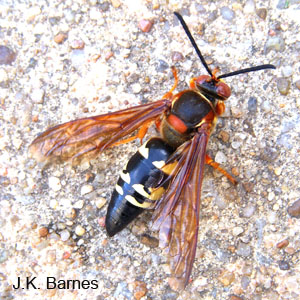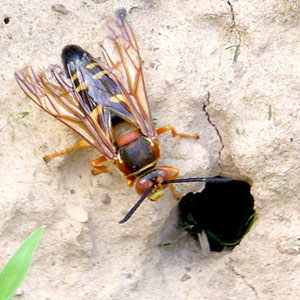Cicada killer
Order: Hymenoptera
Family: Sphecidae
Genus and species: Sphecius speciosus (Drury)


Cicada killers are large wasps, nearly 1 1/4″ long, resembling large yellow jackets or hornets. They are common throughout the United States east of the Rocky Mountains, in areas where annual cicadas are prevalent. Adult wasps appear about the first week of June in Arkansas, at about the time when cicadas begin to emerge. Females are twice as large as males. After mating, the females excavate nests in the ground, usually in full sun where vegetation is sparse and the soil is light and well-drained. They loosen compacted earth by biting at it with their mandibles. They then use their forelegs to push the soil under their bodies and their hind legs to expel the dirt from the tunnel. The excavation activities often create mounds of soil in lawns. Each female digs burrows 6-10″ deep and oval chambers perpendicular to the main tunnel that hold each of her sixteen or so eggs along with the paralyzed prey. She hunts cicadas, and after locating one, she paralyzes it with her sting and transports it to her elaborate underground burrow. The prey can weigh up to three times as much as the predator, so most wasps drag cicadas along the ground and up a tree or other vertical object, from which they can launch themselves downwards toward their burrows. The female wasp places an egg under a femur of one of the cicada’s middle legs and then seals the cell. The wasp larva hatches in a day or two and grows rapidly while feeding on the cicada, completing development in less than 2 weeks. It spins a cocoon and remains in the cell until the next spring. A cicada killer sting causes sharp pain that may last as long as a week, but these wasps are not aggressive, and they sting only when provoked. The average life span of an adult female is only two weeks.
References:
Coelho, J. 2002. Spurred on to greater depths: large barbs on her hind legs turn a female cicada killer into a soil-moving machine. Natural History 111 (6): 20-22.
